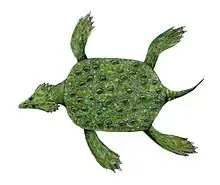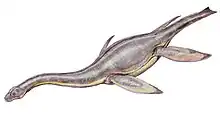| Abyssosaurus Temporal range: Early Cretaceous, | |
|---|---|
 | |
| Life restoration | |
| Scientific classification | |
| Domain: | Eukaryota |
| Kingdom: | Animalia |
| Phylum: | Chordata |
| Class: | Reptilia |
| Superorder: | †Sauropterygia |
| Order: | †Plesiosauria |
| Family: | †Cryptoclididae |
| Genus: | †Abyssosaurus Berezin, 2011 |
| Type species | |
| †Abyssosaurus nataliae Berezin, 2011 | |
Abyssosaurus is an extinct genus of cryptoclidid[1] plesiosaur known from the Early Cretaceous of Chuvash Republic, western Russia. It possessed a shortened skull, and it has been suggested that it primarily inhabited the bathyal zone.[2]
Discovery
Abyssosaurus is known only from the holotype specimen, Museum of Chuvash Natural Historical Society (MChEIO) no. PM/1, a partial postcranial skeleton. The holotype was collected in Poretskii District of Chuvashia, near Mishukovo, dating to the late Hauterivian faunal stage of the Early Cretaceous, about 133-130 million years ago. The specimen was initially thought to occupy an intermediate position between the Late Jurassic Tatenectes and Kimmerosaurus and the Late Cretaceous Aristonectes and Kaiwhekea. Berezin (2011) considered Abyssosaurus to represent the first reliable record of Aristonectidae in Russia.[3] A large phylogenetic analysis performed by Roger Benson and Patrick Druckenmiller found it to be a derived cryptoclidid closely related to Colymbosaurus.[1]
Description
Abyssosaurus was a large plesiosaur, measuring 7 metres (23 ft) long.[3] Its skull length was about 30 centimetres (12 in) and neck length was about half its body length, which would be approximately 3.5 metres (11 ft).[4][3]
In 2019, Alexander Yu Berezin described the overall anatomy of Abyssosaurus in great detail. The maxilla is noted to possess features similar to those present in immature elasmosaurids. The apex cutting edge deflects forwards at a 110° angle, and the rear part of the bone is undeveloped, protruding backwards in the form of a small spike. Berezin notes that the maxillary restructuring is associated with the overall structure of the skull. The eye sockets are large and rounded, more so than in most other cryptoclidids. The overall skull is extremely short and triangular.[2]
Abyssosaurus's gastralia exhibit pachyostosis, apparently with the sole purpose of making the animal less buoyant.[2] Indeed, O'Keefe et al noted that such a build would make a plesiosaur more resistant to turbulence, allowing it to maintain stability.[5] The flippers, too, display pachyostosis, and rear flippers of Abyssosaurus were longer than the front flippers. This is a trait also seen in other colymbosaurines.[2] Based on this, Berezin suggests that Abyssosaurus and other colymbosaurines were efficient divers, able to hover in a diagonal position above the seabed while searching for food.[2]
Taxonomy
Initially, it was suggested that Abyssosaurus was intermediate between Tatenectes and Kimmerosaurus, two cryptoclidids, and Aristonectes and Kaiwhekea, two elasmosaurids. Later analysis suggests that it was a colymbosaurine cryptoclidid.[6] Below is a phylogenetic tree of the Cryptoclididae, after Benson & Bowdler (2014):[6]
| ||||||||||||||||||||||||||||||||||||||||||||||||||||||||||||||||||||||||||||
Palaeobiology
In an attempt to explain the peculiar anatomy of Abyssosaurus, Berezin noted that adaptation to cold, harsh, deep-sea conditions is accompanied by the loss of ontogenetic stages. Organisms not only retain the paedomorphic features of their young, but also exhibit behaviours similar to those of much younger animals—slow, relatively sedentary lifestyles. Such organisms typically spend a great deal of time growing up, and have a long life expectancy. The sperm whale's behaviour and morphology, for example, allow it to rest for a long time after a series of deep dives, sleeping vertically near the surface of the water.[2] Abyssosaurus probably dwelled and fed primarily in the bathyal zone, occasionally rising up to the surface to take in a gulp of air. Indeed, the staple foods of the cryptoclidids, crustaceans and cephalopods, were present in this environment.[2]
See also
References
- 1 2 Benson, R. B. J.; Druckenmiller, P. S. (2013). "Faunal turnover of marine tetrapods during the Jurassic-Cretaceous transition". Biological Reviews. 89 (1): 1–23. doi:10.1111/brv.12038. PMID 23581455. S2CID 19710180.
- 1 2 3 4 5 6 7 A. Yu. Berezin 2019 "Morphofunctional features of the plesiosaur Abyssosaurus nataliae (Plesiosauroidea: Plesiosauria) in connection with adaptations to a deep-water lifestyle." Ministry of National Resources and Ecology of the Russian Federation [in Russian].
- 1 2 3 Berezin, A.Y. (2011). "A new plesiosaur of the family Aristonectidae from the early cretaceous of the center of the Russian platform". Paleontological Journal. 45 (6): 648–660. doi:10.1134/S0031030111060037. S2CID 129045087.
- ↑ Berezin, A.Y. (2018). "Craniology of the Plesiosaur Abyssosaurus nataliae Berezin (Sauropterygia, Plesiosauria) from the Lower Cretaceous of the Central Russian Platform". Paleontological Journal. 52 (3): 328–341. doi:10.1134/S0031030118030036. ISSN 0031-0301. S2CID 91151554.
- ↑ O'Keefe, FR; Street, HP; Wilhelm, BC; Richards, C; Zhu, H; 2011 "A new skeleton of the cryptoclidid plesiosaur Tatenectes laramiensis reveals a novel body shape among plesiosaurs." Journal of Vertebrate Paleontology. 31 (2): 330–339.
- 1 2 Benson, RBJ; Bowdler, T; 2014 "Anatomy of Colymbosaurus megadeirus (Reptilia: Plesiosauria) from the Kimmeridge Clay Formation of the UK, and high diversity among Late Jurassic plesiosauroids." Journal of Vertebrate Palaeontology. 34 (5): 1053–1071.






.png.webp)